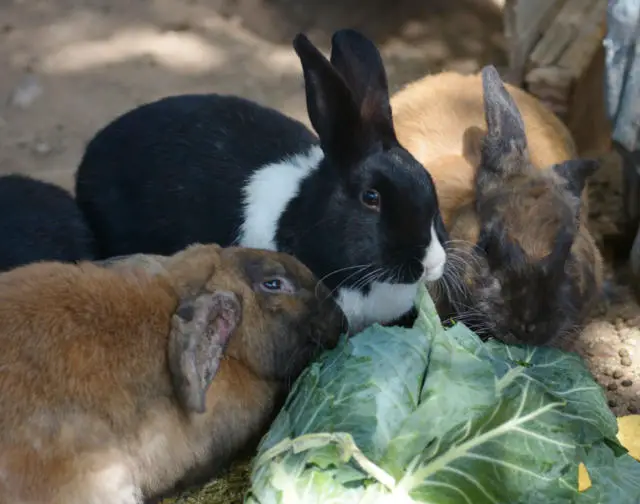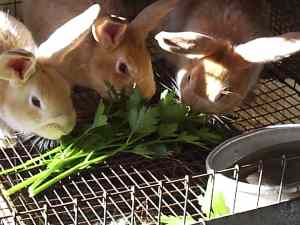Do Rabbits Eat Collard Leaves In Garden
Image Source
Collard greens are vegetables that fall under the Brassica Oleracea group. They belong to the same category with cabbage, broccoli, kale, savoy, kale, kohlrabi, Brussels sprouts, and gai lan. These greens are also known with other names, including the Sukuma wiki (East Africa), mbida (Zimbabwe), haakh (Kashmir), and Couve (Portugal and Brazil).
Collard greens are filled with nutrients, proteins, vitamins A, B1, B2, B3, B5, B6, B9, as well as Vitamins C, E, and K. There is no question about the health benefits of collard greens. But the question is, are these vegetables safe for rabbits?
Are Collard Greens Safe for Rabbits?

Image Source
The short answer is yes. Your rabbits are safe to consume collard greens. In fact, these vegetables are among the safe rabbit greens that you can feed your pet. Others include romaine lettuce, cabbage, kales, endive, dandelion greens, turnip greens, spinach, and similar varieties.
It has also been noted that these vegetables are filled with a high amount of calcium, which is why some owners and experts suggest feeding them to your pets quite sparingly. As a warning, however, if your rabbit has a bladder or kidney problem, it may not be best to feed them with collard greens.
The Components of Collard Greens
When you take a look at the calcium content of collard greens, you cannot help but notice that it is composed of about 140 mg of calcium per 100 g. A medium-sized rabbit has a calcium requirement of about 510 mg every day. It is also recommended to combine collard greens with other food items.
In fact, they are best to be mixed with at least five to six other leafy vegetables in order to achieve a completely nutritious mix. To balance the calcium quantities, collard greens may be mixed with other leafy green vegetables with the lower calcium content.
One recommended recipe is adding one cup of chopped collard green mixture. This is already enough for a rabbit that weighs 2 pounds. Aside from that, it is recommended to ensure the variety of the leafy greens that you feed to your pet because they will surely appreciate the varying tastes and textures given to them.
Feeding Collard Greens to Your Pet
If it is your first time to feed collard greens to your pet, you may notice some hesitations and adjustments needed. Just like any other type of food that is new in the eyes and palate of your rabbit, it has to be introduced slowly throughout a period of about a week. It is best to start with smaller quantities, eventually checking how your rabbit's tummy reacts within a period of 24 hours.
If, after 24 hours, you notice gas, diarrhea, as well as intestinal disturbances, including bloating, it may be best to revert to their ordinary diet. On the other hand, if the stomach of your pet handles it pretty well, you may increase the number of collard greens gradually, right up to the amounts recommended.
Also, it is highly important to make sure that the source of your collard greens is free from pesticides and other harmful chemicals. Make sure that the vegetables do not have molds, and are cleaned thoroughly. After all, they could be carrying around some parasites in the intestines, which include tapeworms, roundworms, and others, especially those in the infective stages. To be safe, you may want to go for the fresh ones.
Another thing to note is that it is not recommended to replace the recommended diet of your rabbit with any fresh food even when they love it. Note that your rabbits also require about 80% hay. There are recommended brands out there, including Timothy Grass, Standlee Premium Western Forage, Kaytee Timothy Hay, and others.
Other Foods to Feed Your Pet

Image Source
Just like humans, rabbits also love having a good meal. A nice, healthy meal means a nice mix of vegetables, which include collard greens, hay, pellets, and freshwater. A balanced diet like this will make sure that your rabbit stays happy and healthy.
· Other Vegetables
A wide assortment of vegetables needs to be part of your pet's everyday diet. When selecting vegetables, make sure to look for one that is free of pesticides, and of course, fresh. Make sure to wash your vegetables well before giving them to your pet.
New vegetables should be provided in smaller quantities until you can determine whether your rabbit will react well to them. Avoid feeding your rabbit leaves from houseplants since they may turn out to be poisonous to rabbits.
Aside from collard greens, your rabbits may also love basil, bok choy, carrot tops, broccoli leaves (minus the tops or stems, as they can make the rabbits gassy), cilantro, celery, clover, dill, dandelion leaves, kale, lettuce, parsley, mustard greens, mint, watercress, and parsley.
· Hay
Fresh hay should make up 80% of your pet's diet. As such, it is important to ensure that you have it all the time. Adults can eat grass, timothy and oat hays, whereas younger ones need to be fed alfalfa. Alfalfa is not recommended for adults due to the higher sugar and protein content.
Hay is essential to the health of your rabbit since it provides the needed fiber for good digestive health. At the same time, it also helps in wearing a rabbit's teeth down as it grows continuously. Putting hay at the end of the litter box will further help them learn to use the litter box, as rabbits have the tendency to eat hay and just poop simultaneously.
· Pellets
Pellets need to be purchased to ensure that they are fresh. Rabbits are observed to be quite sensitive, even turning their noses up when given with stale pellets. Search for pellets that are high in fiber content and low in protein.
As a responsible owner, it is recommended to limit the pellet intake of your rabbit as they continue to age. Pellets that are high in protein may further result in obesity, as well as other health issues. Avoid feeding pellets that come with treats mixed in, as these additives are not healthy for your pets, and can even cause some digestive problems.
· Fresh Water
Freshwater should always be present for your rabbits to drink. If they are placed inside a cage, a hanging water bottle is a good option. They also drink from a water bowl. If the weather is especially hot, you may want to drop a couple of ice cubes in the water dish. If you notice that your rabbits are not drinking enough amount of water, then you may leave the collard greens fairly wet when provided to them. Water is very important to their health as well.
Conclusion
All in all, your rabbits deserve healthy food as part of their balanced diet, just like humans. When it comes to food, hay makes up most of their diet. Other items, including vegetables, can be provided as well. Collard greens, which belong to the same group with other common vegetables such as lettuce, kale, broccoli, and others, are safe for your pets. When fed in their recommended amount, they will do wonders with the health of your rabbits.
Do Rabbits Eat Collard Leaves In Garden
Source: https://herebunny.com/care/feeding/can-rabbits-eat-collard-greens
Posted by: stephenbuslow.blogspot.com

0 Response to "Do Rabbits Eat Collard Leaves In Garden"
Post a Comment